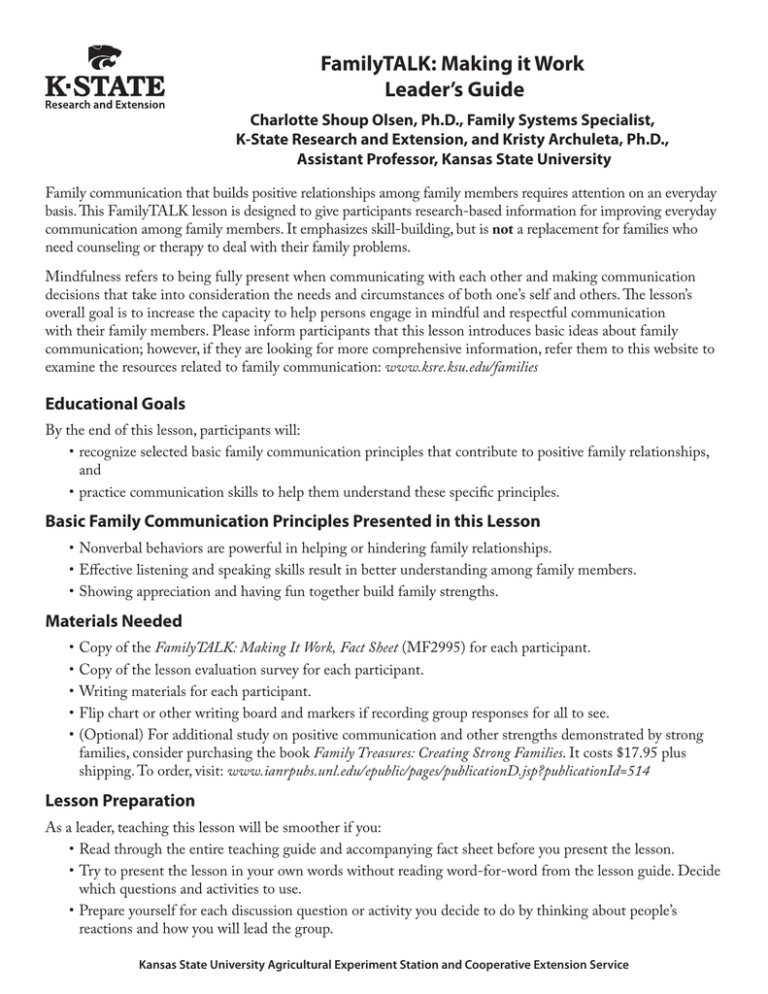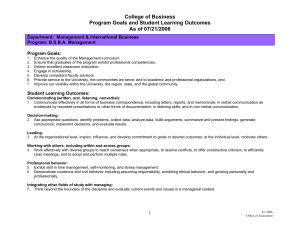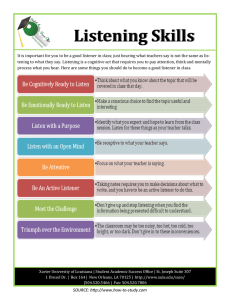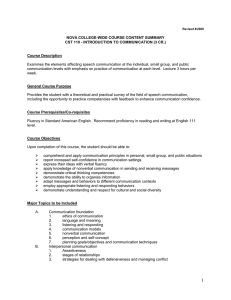
FamilyTALK: Making it Work
Leader’s Guide
Charlotte Shoup Olsen, Ph.D., Family Systems Specialist,
K-State Research and Extension, and Kristy Archuleta, Ph.D.,
Assistant Professor, Kansas State University
Family communication that builds positive relationships among family members requires attention on an everyday
basis. This FamilyTALK lesson is designed to give participants research-based information for improving everyday
communication among family members. It emphasizes skill-building, but is not a replacement for families who
need counseling or therapy to deal with their family problems.
Mindfulness refers to being fully present when communicating with each other and making communication
decisions that take into consideration the needs and circumstances of both one’s self and others. The lesson’s
overall goal is to increase the capacity to help persons engage in mindful and respectful communication
with their family members. Please inform participants that this lesson introduces basic ideas about family
communication; however, if they are looking for more comprehensive information, refer them to this website to
examine the resources related to family communication: www.ksre.ksu.edu/families
Educational Goals
By the end of this lesson, participants will:
•recognize selected basic family communication principles that contribute to positive family relationships,
and
•practice communication skills to help them understand these specific principles.
Basic Family Communication Principles Presented in this Lesson
•Nonverbal behaviors are powerful in helping or hindering family relationships.
•Effective listening and speaking skills result in better understanding among family members.
•Showing appreciation and having fun together build family strengths.
Materials Needed
•Copy of the FamilyTALK: Making It Work, Fact Sheet (MF2995) for each participant.
•Copy of the lesson evaluation survey for each participant.
•Writing materials for each participant.
•Flip chart or other writing board and markers if recording group responses for all to see.
•(Optional) For additional study on positive communication and other strengths demonstrated by strong
families, consider purchasing the book Family Treasures: Creating Strong Families. It costs $17.95 plus
shipping. To order, visit: www.ianrpubs.unl.edu/epublic/pages/publicationD.jsp?publicationId=514
Lesson Preparation
As a leader, teaching this lesson will be smoother if you:
•Read through the entire teaching guide and accompanying fact sheet before you present the lesson.
•Try to present the lesson in your own words without reading word-for-word from the lesson guide. Decide
which questions and activities to use.
•Prepare yourself for each discussion question or activity you decide to do by thinking about people’s
reactions and how you will lead the group.
Kansas State University Agricultural Experiment Station and Cooperative Extension Service
•Prepare materials as indicated under the “Materials Needed” section.
•A leader script is indicated in italics throughout the lesson.
The Lesson
Introduction
Hand out writing materials and ask participants to draw stick figures of their family. “Family” can be defined
as they wish. Then, ask them to introduce themselves to the group and briefly describe who is in their drawing.
Complete this activity by asking what they hope to learn during the lesson to address family communication
concerns. Remind the participants that sharing in the group discussions throughout the lesson is totally voluntary.
Help the participants understand that today’s goal is to put into action what you know and understand about
positive family communication. This lesson is to reinforce skills that keep communication open and respectful, and
to build family relationships.
Emphasize that communication is the key to building or hindering
relationships among family members. Use your own family picture
from the warm-up activity to illustrate how many family relations exist
within any family unit. For example, if there are four persons in your
family, there are six one-on-one relations. Each relationship has its own
communication pattern. Among your family members, there may be
different communication dynamics when several family members are
together as compared to one-on-one communication. Help the group
recognize that these relationships and communication patterns become
more complicated with stepparents, grandparents, and other family members who are important to the family.
Use the following activities to teach the communication concepts in the lesson. Additional activities are available
from the author, Charlotte Shoup Olsen, colsen@ksu.edu. References for this lesson are included in the fact sheet.
Activity 1
Ask the group to think about a specific time when they
were satisfied with their family communication. It could be
a specific incident or over a period of time. Have them think
about how each person communicated with others, how
individuals reacted to each other, and what were specific
actions, gestures, and verbal or nonverbal behaviors. Spend
time having the participants react to their memories, sharing
their thoughts and feelings. Also, ask them to share times
when they felt appreciated and times when they showed
appreciation to others. Here are possible follow-up questions
with a summary of key points to emphasize:
What did you learn from these stories?
What did you learn about family communication?
What were things in common mentioned during this discussion?
What are the messages sent when family members show
appreciation to each other?
There are similarities and differences in how families communicate.
A family member may communicate differently with individual
family members. Family communication is impacted by many
things: timing, setting, individual personalities, family history, the
community, economic situations, and other happenings outside
the family. For the most part, family communication tends to be
spontaneous talk when no one is particularly thinking about it.
It can be enjoyable just listening and talking to each other. The
signals of appreciation to each other build strong relationships,
too. It can be as simple as a truthful ‘thank you for doing that’ with
nonverbal behaviors that show you are honest and sincere. Families
who do the opposite – devalue and belittle each other – are moving
their relationships along a bitter, negative path. Then families who
do not pay attention to each other and are indifferent to each
other can find family relationships declining with more of a sad
note than one of bitterness. There are some basic communication
principles that strong families use — and are very important to use
— especially when family members don’t agree with each other for
one reason or another.
Activity 2
Let’s turn our attention to nonverbal behaviors that affect family
communication such as facial expression, body language, and
other messages that we get from others without a word being
spoken.
What would you like most from a family member who is listening
to you?
What have we learned from this experience? Nonverbal messages
are powerful. Think about facial expressions, body postures and
actions, body space boundaries, and appropriate eye contact
Ask the group to stand up and walk around without
acknowledging or smiling at each other as they meet. Next, tell and how they are important in knowing if your family member is
them to continue walking and look and smile or whatever they listening. The term “appropriate eye contact” is used since some
families consider direct eye contact with elders and authority
want. Ask them how it felt to not acknowledge each other.
figures to be disrespectful.
Ask them to pair off and get six feet apart and try to talk. Ask
them to get nose to nose. Then tell them to get comfortable,
Also, it is wise to resist the temptation to make a judgment
as individuals may have differences in how close they like to be
about someone’s nonverbal behaviors and verbal messages,
when communicating with another person. This is called body
too, until you have checked it out. You may think that a
space boundaries.
family member is ignoring you purposely when, in fact, it
Ask pairs to sit facing each other. Decide which one will be the may have been a bad day at school or on the job and this
speaker and the listener. Ask the listener to use active listening person has nothing on his/her mind but that situation. Poor
skills. Active listening skills can be defined as paying respectful communication can occur when a family member interprets
attention to the speaker and showing signs that show you
both verbal and nonverbal messages differently than the
are listening such as nodding the head, etc. When you clap
other family member may have intended. Family members
who carefully listen and observe can share in a respectful
your hands, the listener is to look away, yawn, lean back, and
pay no attention. Have the speaker talk about something that manner, whether they agree or not, what they think are the
happened last weekend in their family. Have them reverse
messages coming from the other person. Getting the message
roles. Here are possible follow-up questions and a summary for right avoids misunderstandings and conflict. However, it takes
much patience and no interruptions to do this when there is
this activity:
a disagreement. Families who develop patterns where each
How did the speaker feel when the listener looked away?
person gets a chance to share and be correctly understood are
building skills that help protect and build their relationships
How did the listener feel when looking away?
with each other.
Why do you think you had these feelings?
Activity 3
Ask for participant reactions to the following two messages:
What was the difference in the feelings?
Message #1
What was the difference in the words?
You NEVER pay attention to me at home. YOU come in the house
after work and go straight to the computer. YOU seem to care
more about playing your silly computer games than me. YOU
really make me feel lousy.
YOU messages escalate conflict because the other person feels put
down, blamed, accused, or guilty. The immediate reaction is to
become defensive or to shut down and not communicate at all.
Message #2
I get frustrated when we don’t pay attention to one another. I
really appreciate spending time together when we get home and
talking about our day rather than going off and doing separate
activities like you playing computer games and me cooking
dinner.
Follow-up questions and summary:
How did you feel when the first message was read?
Did you feel differently with the second message?
Persons who learn to talk about a conflict in a way that is not
offensive to the other person are protecting family relationships.
They are respecting each other. Talking in this manner can often
surprise family members, especially if YOU messages have been
the usual way to communicate. They may be taken aback to learn
how you really feel, but it may take time before the family member
adjusts his/her usual response. Additionally, it helps when messages
that bring up a conflict are well thought out, brought up softly, and
discussed at a time that makes sense to both persons. Timing is very
important. Interrupting an activity that another person is enjoying
will likely produce disappointing results.
In conclusion, you rarely think about communication with loved ones. Family communication is important
and determines relationships between individuals, setting the tone for family life. Of course, families will
have difficulties, but family communication delivered in respectful ways during these stressful times helps
family members protect their relationships with each other. Families who have fun together also are building
strong ties. It can be spontaneous fun in everyday living as well as planned activities together. Positive family
communication and enjoyment with each other have been found to be strengths of strong families worldwide,
regardless of their family structure or living situation.
FamilyTALK: Making It Work Evaluation Form
Directions: Please answer the following questions; however, completing this survey is voluntary. You do not have to answer every
question. You will not be identified with your answers in any way.
1. How do you rate this lesson?
Check one: Excellent____ Good____ Average____ Poor____ No opinion____
2. Do you think this information will be useful to you in your own life?
Check one: Yes____ No____ If yes, how?
3. Because of this lesson, when I communicate with a family member:
I am more likely to use positive nonverbal behaviors. Yes____ No____
I am more likely to use effective listening and speaking skills. Yes____ No____
I am more likely to talk and listen respectfully when there is a disagreement. Yes____ No____
I am more likely to show appreciation to each of my family members several times a week. Yes____ No____
I am more likely to encourage enjoyable family activities. Yes____ No____
4. What did you learn that you did not know or that surprised you?
5. What have we left out in this lesson that you feel should have been included?
6. Will you share this information with others? Yes____ No____ If yes, check those that apply:
FCE____ Other organization____ Family____ Friend____ Other____
7. A
. Are you: Female____ Male____
B. What is your age?____
C. Are you: Single____ Married____ Single, living with partner____ Separated or divorced____ Widowed____
Other comments about the lesson:
Thank you! Please give this survey to your lesson leader. The information you provided will help us improve family life education. If
you are interested in being contacted in the future on the impact of this lesson in your family life, please provide the following:
Name_________________________ Address______________________________________ Phone________ Email_________
For Leaders Only:
Leader’s name: _________________________ Phone number or email:________________ County:_______________
Type of group: FCE____ Other_________________________ Date when lesson was given:____________
Number of people attending: ____ Number of men:____ Number of women:____
Please return completed surveys to your county/district Family and Consumer Sciences agent, or mail directly to:
Charlotte Shoup Olsen, Kansas State University, 343 Justin Hall, Manhattan, KS 66506
If questions, contact Charlotte Shoup Olsen at colsen@ksu.edu
Brand names appearing in this publication are for product identification purposes only. No endorsement is intended,
nor is criticism implied of similar products not mentioned.
Publications from Kansas State University are available at: www.ksre.ksu.edu
Publications are reviewed or revised annually by appropriate faculty to reflect current research and practice.
Date shown is that of publication or last revision. Contents of this publication may be freely reproduced for educational purposes.
All other rights reserved. In each case, credit Charlotte Shoup Olsen, Ph.D. and Kristy Archuleta, Ph.D.,
FamilyTALK: Making it Work, Leader’s Guide, Kansas State University, August 2011.
Kansas State University Agricultural Experiment Station and Cooperative Extension Service
MF2996
August 2011
K-State Research and Extension is an equal opportunity provider and employer. Issued in furtherance of Cooperative Extension Work, Acts of May 8 and June 30, 1914,
as amended. Kansas State University, County Extension Councils, Extension Districts, and United States Department of Agriculture Cooperating, Gary Pierzynski, Interim
Director.








